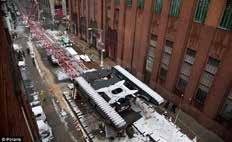
15 minute read
Industry Best Practice of Jib Extension Attachment and Removal
Article contributed by CICA
Crane operators are often required to rig the crane with a fly jib extension to meet site requirements. The primary purpose of using a fly jib is to extend the working height of the main boom; a secondary purpose is to increase radius to move around an obstacle. Like most crane operating tasks, there are risks involved in installing and operating the crane fly jib, so safety is paramount.
Advertisement
To install and use the crane fly jib it is important to always refer to the manufacturer’s instructions. The prescribed sequence of fly jib installation is important to follow, and it will vary between crane models.
The safety of the operator and crew should always be front of mind. Falls from heights is still the number one workplace injury in the construction sector. Fly jibs can often be done near ground level, but just out of reach, so a ladder or work platform is required. It is important to ensure that a secure and footed ladder is utilised. If walking on top of the main boom, ensure the correct harness is used and fits correctly. Make sure the type of lanyard will provide fall arrest before contact with the ground.
As shown on this Tadano GR-800EX-2, there are many components to install and secure the jib both while it is stowed and when in use.
Tadano GR-800EX-2
The manufacturer’s recommended steps to install or remove the fly jib from a crane should be followed, but swing away fly jibs have these common steps:
1. Set up the crane’s outriggers and level the crane.
2.
If the hoist rope that you will be using for the fly jib is already on the main boom, pay out enough rope to install on the fly jib before disconnecting the rope from the boom head.
3. The main boom should be set to manufacturer’s specifications for angle and extension.
4. Unpin the fly jib stowage pins and attach the pivot point of the fly jib to the main boom head.
5.
Stay clear of the swing area of the fly jib by using a tag line and ensure no other obstacles will be contacted when the fly jib is swung into position.
6. Swing the fly jib into position and attach the connecting pin to the other side of the boom head.
7.
Place the wire rope correctly over the sheaves and ensure all guide pins and retaining clips are reinstalled.
8. Reconnect all electronic sensors including moving the anemometer from the main boom to the fly.
9. The boom may have to be raised to a certain angle before the hook block is lifted off the ground.
10. Check the Anti-2 block sensor on the fly jib is working.
11.
Ensure the RCI is programmed to the correct fly jib configuration and angle before lifting commences.

Stowing a HTC fly jib

It is important that the reeving of the wire rope is correct, to be sure it is retained by the guide pins and that retaining clips are secure on the guide pins. The wire rope can act like a saw blade on boom sections or laces if reeved improperly.
When disassembling the fly jib ensure that the boom is retracted to the position so it can be stowed correctly on the support ramp and aligns with the stowage pins.
Do not stand under the jib or on the side of the jib in the area it will pivot, as the jib can rotate freely when the connecting pin is released. Once the fly jib is secured the crane can travel to the next job.
Underslung fly jibs follow a similar procedure, but do not have the main boom horizontal during installation and disassembly. The hoist rope is used with luffing up of the main boom to unfold the fly jib and bring it into position. Once it is in position, the fly jib angle is set.
These steps apply to boom mounted fly jibs on All Terrain, Hydraulic Truck Crane and
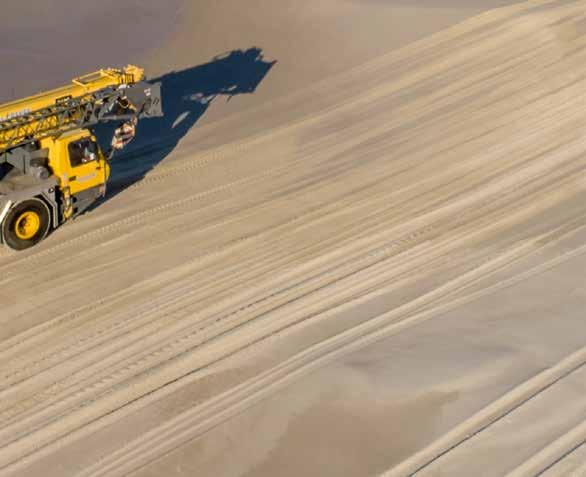
Rough Terrain cranes. This brief overview is an oversimplification for fly jibs that are installed on large capacity hydraulic or lattice boom cranes.
CICA Position Paper, CICA-PA-0005-A, discusses who can assist the crane operator when changing the reeving arrangement or installing a fly jib. Some WHS regulators interpret the Intermediate Rigger HRWL definition to include the installation of swing away and underslung fly jibs as rigging and derigging the crane. CICA’s position is that this activity does not need to be completed by an intermediate rigger but needs to be completed under the guidance of the crane operator following the manufacturer’s recommendations in the operation manual. CICA Members have access to all guidance notes and position papers, go to www.cica.com.au to learn more about CICA membership.
February 2007 Jamestown, South Australia
Project:
Cranes:
The Outcome:
Wind Turbine Installation
Significant property damage including carousel, nitrogen cylinder, main assembly lattice section, and pennant rods. No injuries.
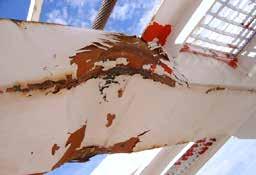
Masts have rotated over causing damage Damage to strut
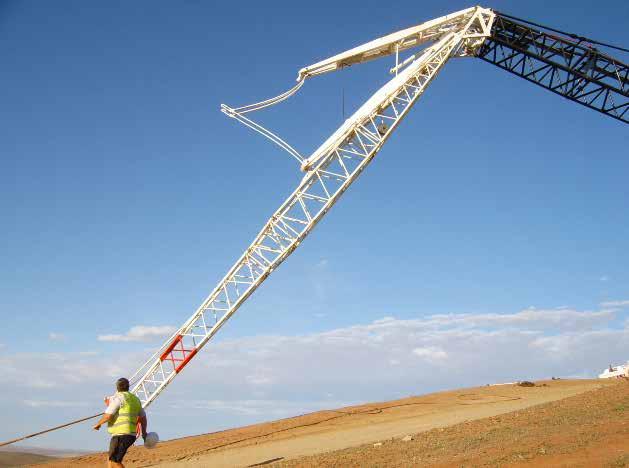
Damaged lacings Initial damage to the carousal when lowering the boom to the ground
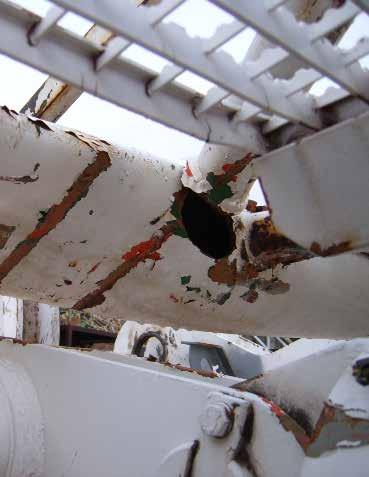
In February 2007, a Liebherr LG-1550 with 63m main boom and 28m luffing fly was being used for a turbine installation project near Jamestown, South Australia. Due to inclement weather and safety concerns, the boom of the crane was unable to be raised for work throughout the day. A decision was made late afternoon to recommence work at 0200 the following day. Shortly after this decision, a break in the wind provided an opportunity to lift the boom and reeve the hook in preparation for the night’s work. The boom was lifted to around 25º and the luffing fly lowered in order to reeve the hook. The hook was reeved and it was observed that the rope had jammed. The boom was then lowered again in order to rectify the rope. The Supervisor instructed the Operator to lift and place the hook and lay the boom for the night. The Operator started to lower the luffing fly (so as to a-frame the boom before lowering to the ground), when the Supervisor observed that the luffing fly was heading forward beyond the point of stability. As the Supervisor hurried to radio the Operator, the A-frame of the carousel fell forward over centre and collapsed onto the luffing fly, causing extensive damage. The primary cause of the incident was luffing the fly down too far. Contributing factors also included fatigue from working in difficult weather conditions (with little to no shelter from the heat and wind) and under pressure due to a pending two AM start.
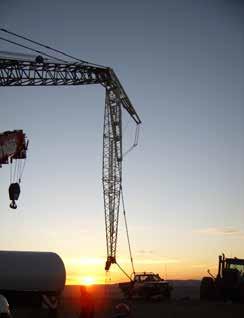
Damage to guy rods
Key learnings from this incident
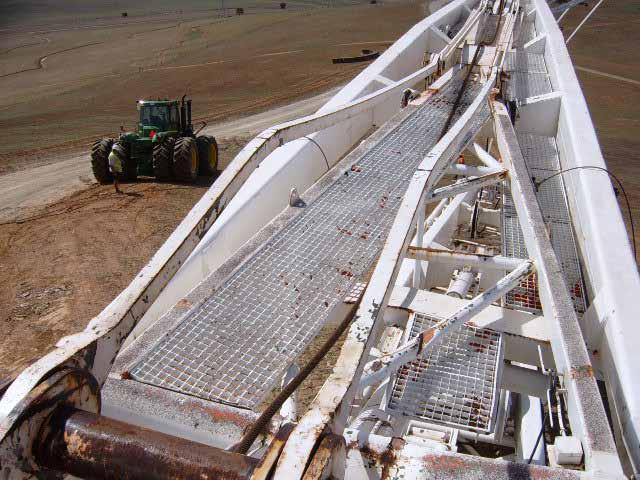
All personnel to read and understand the operations manual, including the specific configuration required for the setup. Have a secondary party check for compliance to machine requirements, and use a tick sheet for final checks on configuration.
Compose individual Safe Work Method Statements (SWMS) for all configurations of machine to ensure all checks and special operations are observed.
Maintain clear communications, and have second/third party guide crane movements to ensure safety at all times.
An awareness of personnel’s health and wellbeing is advantageous especially when working in arduous conditions
September 2017 Miami and Fort Lauderdale, Florida
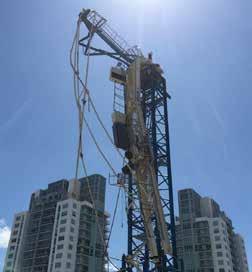
Tower top and counterjib after the incident at the first failure site Tower top and counterjib after the incident at the second failure site
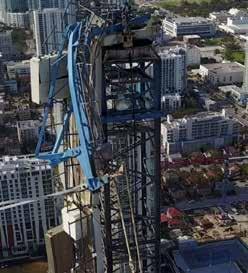
Project:
Cranes:
Multiple building sites
Three x SK-315 cranes
The Outcome: Property Damage
In September 2017, Hurricane Irma hit the west coast of Florida, USA. The tropical storm conditions across Miami and Fort Lauderdale caused the collapse of three SK-315 hammerhead tower cranes that had been put out of service and allowed to weathervane.
In all three crane failures, only the jibs, counterjibs, and the tower top collapsed. The crane masts, ties and foundations remained intact. The cause of the failure was the same in all three cases: the detachment of the crane jib from its turntable due to turbulent wind loads. Once the jib started falling, the two jib pendants were released. The forces on the tower top apex from the jib pendants decreased from the maximum to zero in a short amount of time. The two tower top columns toward the counterjib failed because of the transient load change on the tower top.
a) Jib jumped off the left bearing connection
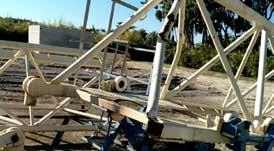
b) Upward turbulence wind detected right after counterweight blocks hit the building
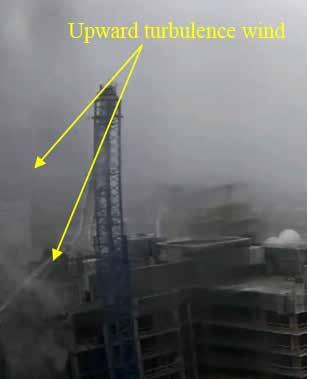
Upward turbulence wind detected when the crane collapsed at the first failure site (Courtesy of Mr. Nick Tangredi) Thankfully no one was injured due to construction being at a standstill and residents either evacuated or taking shelter from the hurricane. There was also limited damage to the construction sites. In the first failure in Miami, the crane had a 180ft jib, 64ft counterjib, and 39 kilopounds (kips) counterweight. All five concrete blocks of the counterweight hit the interior of a 33- storey apartment building, damaging the alreadycompleted floor slab. The second crane failure was located a couple of miles away, involving a SK-315 with a 147ft jib, 64ft counterjib, and 32kips counterweight. All four counterweight pieces fell on the street below piercing the pavement. The third failure was located at a construction site in Fort Lauderdale, approximately 35 miles north of Miami. The crane lost its counterweight but no damage was reported. It is important to note there were over two dozen other cranes in the Miami area alone that did not collapse, including a fourth SK-315 that was positioned at a lower height and protected by tall structures.

Jib foot bearing connections – jib side (the first failure)

Collapsed crane after the incident at the third failure site Aerial view of the second failure site – looking east
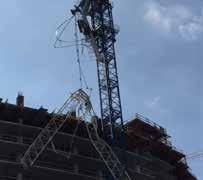
Recommendations from this incident
Occupational Safety and Health Administration (OSHA) were initially called to site to provide technical assistance in the safe dismantling of the cranes. However, the failure of three SK-315 cranes in a similar manner prompted OSHA to launch an investigation, based on suspicions there were potential deficiencies in this particular crane model.
The following includes the recommendations from the investigation conducted by structural engineers from the Office of Engineering Services (in OSHA’s Directorate of Construction), with input and cooperation from the manufacturer and owner of the cranes:
On coastal areas with tall buildings and locations prone to frequent turbulent winds, local governing bodies should consider asking engineers to conduct simulations based on dynamic analysis to get a more realistic wind evaluation than quasi-static analysis. Instead of conducting cost-prohibitive wind tunnel tests, engineers could conduct a Computational Fluid Dynamics (CFD) analysis, which has become affordable due to the rapid advance of software and computing technology.
Terex, the crane manufacturer, should evaluate the design of jib-toturntable connections to prevent possible detachment of crane jibs in high turbulent wind in the future.
To prevent catastrophic collapses of the crane tower top in the future, it is recommended that tower tops be evaluated and designed with a higher safety margin, and the design should also be based with loads applied from only the counterjb.
The jibs in all three cranes were suspended by single pendants. In the event that the jib begins to sway to the sides, the single pendants could not be expected to secure the stability of the jib. It is, therefore, recommended that two symmetric pendants or cables be considered in the design of the tower cranes. Terex should consider adding pendants to the existing SK- 315 models.
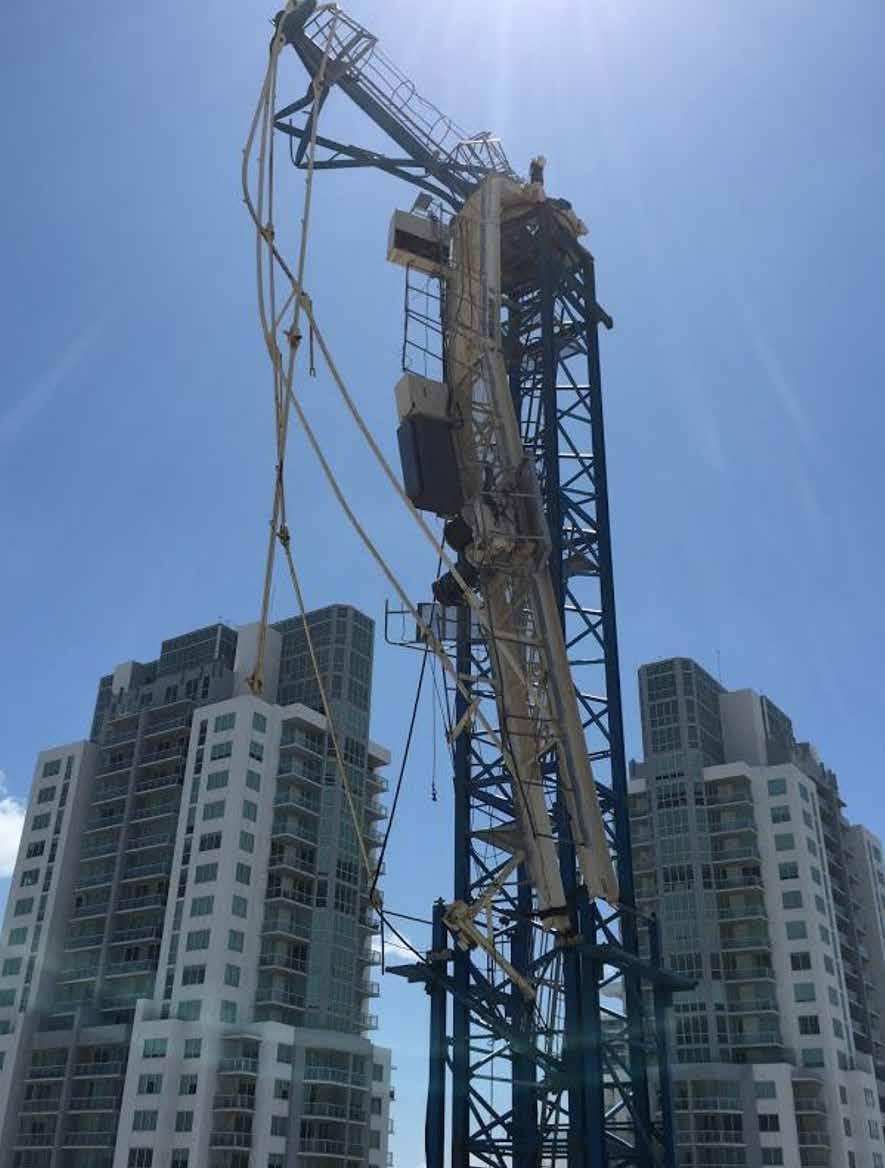
Incident Gallery
April 2021 Christchurch, New Zealand
OUTCOME: CRUSH INJURY

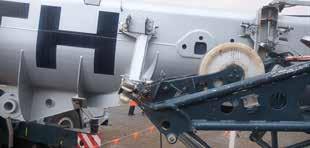
In early 2021, a Grove GMK-5130-2 with 28.5t counterweight complete with a 3.6m heavy duty ISS panel jib was being used to rotate and place concrete panels on a site in Christchurch, New Zealand.
The Operator started the process by removing the ancillary hook and rooster sheave. He then raised the deflection sheave, before slowly releasing the safety mechanism of the front connection. However, the Operating Instructions Lattice Extension for Grove was not referred to during the operation, resulting in several steps of the process being skipped. These steps included releasing the rear connection, swinging the ISS on to the main boom head, and pinning it to the right-hand side, before releasing the front connection.
Missing these steps resulted in the 825kg jib falling and crushing the operator against the top rail of the EWP.
January 2019 Charlottesville, Virginia
OUTCOME: INJURY AND BUILDING DAMAGE
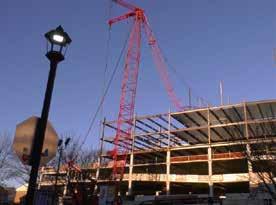
A crane partially collapsed at a building site in Charlottesville, Virginia, in January 2020, injuring a construction worker.
The Manitowoc’s luffing jib came down on the 4th and 5th floors of a new office block under construction. Whilst the crane operator was uninjured on the ground level, a construction worker on the upper floors of the building suffered a compound fracture to his leg.

Emergency services were called in to rescue to worker. He was lowered to ground floor using a tower ladder truck, before being transported to the University of Virginia Medical Center with non life-threatening injuries.
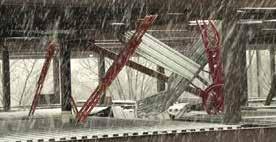
It is thought the jib pendant cables or retaining pins failed, allowing the jib to drop, however Occupational Safety and Health Administration were working with the construction company to investigate the cause of the incident.
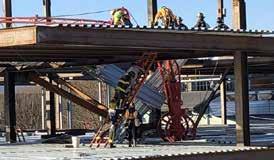
NBC29 News
NBC29 News
NBC29 News
WRAL News
February 2021 Brooklyn, New York
OUTCOME: NEAR MISS

NY Post
The jib of a Potain luffing tower crane dropped in February 2021 due to a failed luffing mechanism. The crane was located at the site of a 31-storey luxury high-rise development in Brooklyn, New York.
According to the New York’s Department of Buildings preliminary investigation, “technicians were on site performing maintenance work on the tower crane when the crane's boom experienced a partial collapse.” It is estimated the portion of the crane that collapsed measured 175 feet (approx. 53m).
The jib was facing away from the building when it collapsed against itself, causing no damage to the tower construction project. Thankfully there were no injuries to workers or passersby.
November 1998 Liverpool, England
OUTCOME: FATALITY
BBC News UK
In November 1998, a crane hire company was lifting telecommunications equipment from a ground level car park to the 12th floor of the Royal Liverpool University Hospital using a Demag AC-755.
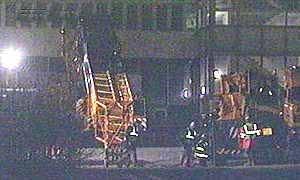
The crane had been working on its main boom with a fixed fly jib extension. A second crane was being used to add an extra 6m lattice section of fixed fly jib to the tip of the telescopic boom when the incident occurred. As the existing fixed fly jib configuration was dismantled and pins were removed, two boom sections – weighing 2.4t and 1.6t – collapsed.
One of the lattice structures struck the 27-year-old operator as it fell. Medical personnel tended to the operator at the scene, however he later succumbed to multiple chest and abdominal crush injuries.
February 2016 New York, New York
OUTCOME: FATALITY AND MULTIPLE INJURIES
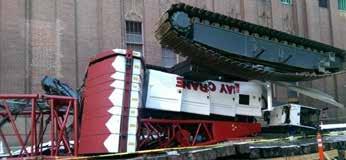
A Liebherr LR-1300 crawler crane collapsed in New York in February 2016, resulting in a fatality and multiple injuries. It had been positioned to replace generators and cooling towers on the roof of a 25-storey building.
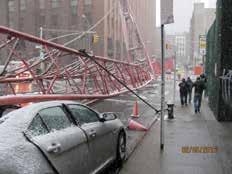
Due to inclement weather conditions (high winds and snow), it was decided to lay down the 371ft luffing jib and 194ft boom. With the boom angle at 69.4° (less than the manufacturer’s recommended 75°) and the luffing jib at 45°, the Operator began to lower the crane. The wind increased, flipping the boom and jib towards the ground, overturning the crane at 180o.
Boom and jib on the ground after the incident – street view
As it collapsed, the jib head hit several buildings causing damage. The boom of the crane fell onto a motorist’s parked car resulting in a fatality of the owner standing nearby, and injuries to two others in nearby vehicles. The crane operator sustained minor injuries.
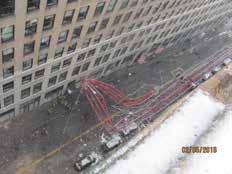
An investigation into the incident by the Occupational Safety and Health Administration (OHSA) found “the crane tipped over or overturned as it failed to remain stable under a decreasing boom angle and increasing wind”. It was also found that the crane hirer was aware of impending weather conditions the day before the incident but did not take preventative action to stow/park the crane overnight.
Jib head section after the incident – aerial view
